October, that time of year when horror franchises march out their newest edition and try to convince you that you haven’t seen this movie before. This year, 2015, we have another Paranormal Activity, The Scout’s Guide To The Zombie Apocalypse, and, scariest movie of the season, a Bradley Cooper movie where he’s not playing a racoon.
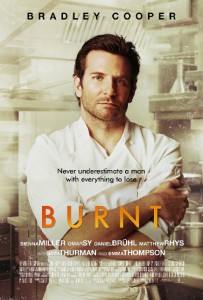
I haven’t seen any of this year’s crop. The last Zombie movie I went out of my way to watch was Zombieland and I haven’t watched a Paranormal Activity since the first one. So I’m just going to guess right off the top of my head, based on what I’ve seen of the Paranormal Activity franchise, that there’s a lot of jump scares in there. For those not in the know, that’s one of these.
But I’ll give them a benefit of a doubt and say they’re only 50% jump scares. That’s being pretty generous in the modern horror scene, with a great deal of horror franchises being anchored now into the old slasher model. It used to be that the only time you could expect a solid wall of jump scares was when a maniac with a mask and a machete were involved. But now they’re basically everywhere and a lot of horror critics are jumping onto the bandwagon that the genre is full of lazy hacks. But I have a different opinion.
They’re not lazy, they’re ignorant…
The Easiest Scare To Understand
I can understand why people would think that the jump scare is simply a matter of being lazy. The basic structure of a jump scare is easy to understand, easy to set up, and fairly universal for the first couple instances. You just take a situation with some tension, build it using the appropriate music, and then spring it on people like a mousetrap when you’ve given them some time to cook. For the first time, the results are pretty quick and easy.
But after a while it starts to feel lazy because it stops working. If you see the jump scare coming (and we all do after the first couple), you’re going to notice that the building music is indicating it’s coming. To put it in terms that are common to gamers: if you notice a lot of extra items all of a sudden and the game just saved or gave you a save point – the boss is in the next room. The same holds true for jump scares: if you hear the music building or notice that everything just got really quiet, something’s about to burst out of the shadows.
But once you start to expect it, the jump scare loses effectiveness because the entire reason why it’s scary is that you don’t see it coming. The human brain is designed to be spooked by things it doesn’t expect, so if it expects it, it’s not scary. This is why people who work with snakes all day can just smack them on the head when they’re out of sorts but the rest of us would be shivering in the corner. I have a severe dislike of black widow spiders, but my dad, who worked in attics for over half of his life, can crush them with his bare hands without flinching. We, like the frog in hot water analogy, acclimate to the things around us and take a cue from them.
The thing is, once it stops being scary, we start to think about it. Worse, we start to take notice of how often we’re sitting there and thinking about it. And when you start to think about it, the fact that the jump scare requires the least amount of effort starts to become impossible to miss. It’s inevitable that someone will start to feel like it’s simply a lack of effort. But I hold that it’s something far more complicated: jump scares aren’t the go to because they’re easy to do, they’re the go to because they’re easy to measure.
People are often familiar with the idea of fear and what scares them. We know what makes our skin crawl and what makes us dash away for safety. We have a rough idea of what makes other people afraid too, especially if it turns out our fears are common. The problem lies in trying to figure out what scares the most people most effectively and tapping into that. How would you be able to figure out what people are afraid of without having to ask every single person you find? You listen to them and watch them react.
If you fill a theater full of people and you watch a horror movie with them, you can know what’s working and not working for you, but reading everyone else is more complicated. Every scream, every startled gasp, every sudden cringe is a signal to you that what happened didn’t just scare you – it scared others too. So what’s the thing that produces those reactions the most?
Exactly. The jump scare is the easiest thing to find the common denominator for and it’s the thing that you know is going to work. It’s not simply because they’re lazy, it’s because they don’t have better information. Anything else is a risk because not everything happens to scare people in the same way. Some people get painfully bored of certain things, aren’t impacted at all by others, and have acclimated to situations which aren’t “startling”. But the jump scare? Not only do you know it will work for many people, but for a lot of people it will continue to work for at least an hour and a half.
Not having an attachment to an audience means you don’t have a direct line into what makes that audience tick. This is part of why I believe being a horror novelist is harder than being a horror screenwriter. Screenwriters can rely on the information they get from the screams, but horror novelists have to operate on the silent form of fear – dread. Dread is quiet, unrelenting, and without excitement. Being startled can make your heart race, dread can make you feel like it’s gone all together. But, funny enough, the two of them can work quite well together – and that’s where jump scares, smart jump scares, can be used for great effect.
I avoid writing horror novels myself, they don’t really work on me (more on that Wednesday), so I don’t wade in that direction too often. However, I do sometimes go in the direction of “creepy”. My current novel series is in a world full of monsters and bizarre creatures – I have to make some things a little creepy from time to time. And, to my benefit, I have direct feedback to tell me just what is and isn’t creepy. Because of this, I have an insight into what scares others more than what scares me. In fact, the last time I tried to do something creepy, the worst part of it was a single image.
As you can see, no jump scares, no sudden bursting out of the shadows. You’re looking at an image of a “Rake” crawling out of a compartment into someone’s room. It’s a simple visual, a spindly, contorting figure slowly clawing its way to freedom. But it’s effective none-the-less. It’s just a very surreal and uneasy image of something that shouldn’t exist doing something that shouldn’t happen.
My friend, reading through the article and coming to that image, then had the unfortunate timing of her phone buzzing at that very moment. One image, in silence, had put her on edge. Combined with a sound, that suddenly changed the situation dramatically.
You could argue that means the image wasn’t scary on its own, but I argue that she would have had to have been scared in the first place for the phone to do that. Phones buzz constantly, they’re suddenly springing into our life all the time, but when you’re scared you don’t really want any new sounds. It wasn’t that the noise itself was suddenly startling, but that the noise itself coincided with a visual that had her feeling uneasy in the first place. By that standard, any sound to go with that visual would have put her in the same horrible state of mind. Essentially, the image scared her, put her in dread, and the phone made part of her mind wonder if the image was in the room with her.
So that brings the real power of the jump scare, the real effective use of it. The goal of the jump scare shouldn’t be to get the cheap scream every few minutes but to be the exclamation point on everything else done up to that point. If you have the benefit of a jump scare, like screenwriters do, then it could become this amazing tool to punctuate an hour of dread. The question is, how do you set up that dread?
I think the problem is that a lot of horror screenwriters spend their time watching horror movies rather than reading horror novels. If you read the best horror novels, most people are going to understand dread by the end. After all, the book can’t spring to life and scream at you, so any horror novel that got a lot of attention is going to have to do it another way. Simply watching horror movies is never going to be enough to put that into perspective. A horror movie audience shows its fear by screaming, a horror novel audience shows its fear by leaving the light on all night. That’s something that requires study.
The funny thing is, thanks to the internet, I think that’s about to change. A lot of indie horror directors are getting their inspiration from what’s gotta be the greatest source of public domain dread available – creepypasta forums. The likes of Slenderman, the Rake, and many other horrible entities are born of a place where you learn to be afraid of the dark in a couple paragraphs or less. Hell, the internet has distilled this into a couple sentences in some examples.
So the things starting to come out of the independent circles, as a result, have all the earmarks of a horror vocabulary taught by simple, unadulterated dread. The screenwriters of old, raised on slasher flicks, can also tap into this resource as well. With this stuff floating on the web, it’s an easier time than any to become educated on the more complex nature of fear without a scream. But, for now, let’s just admit…
It’s hard to deny what works.
(I write novels and have a twitter account. The scariest part is that I’m still doing it.)


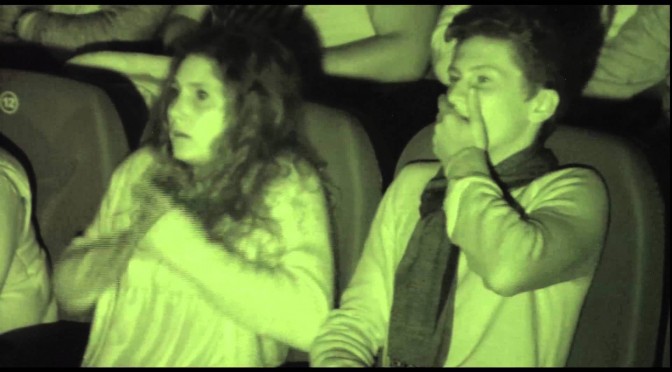
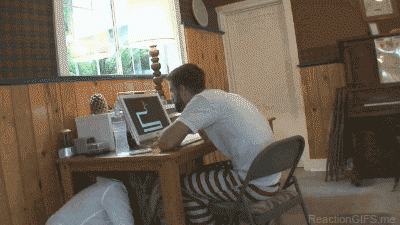
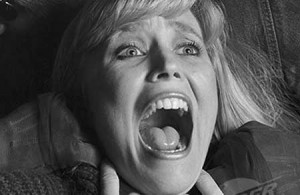
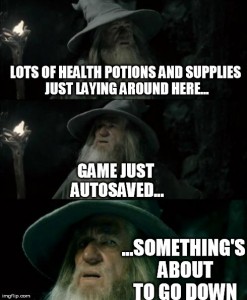
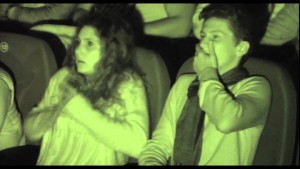
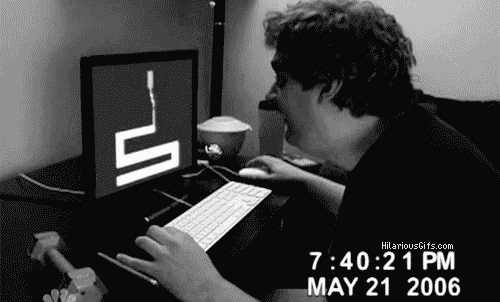
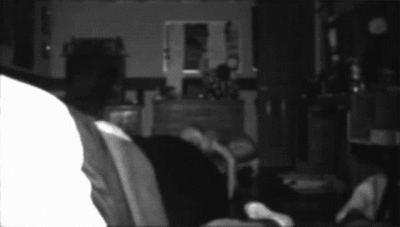
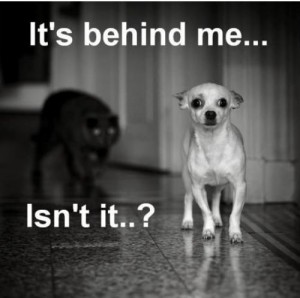
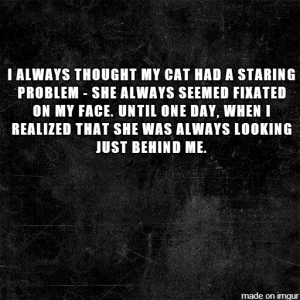





I think jump scares are necessary to a point – like you say, you need them to punctuate suspense every now and then. If you had all build up and no pay off then that would be untenable. That said, they do get boring and over used.
My favourite jump scares are the ones that seem really obvious, and you’re sitting there going “Oh, the character is in the left of the frame, something’s going to pop up to the right behind them”…”any minute now”….”yeah something’s going to happen”…”I could’ve sworn that was going to be a jump scare”…”Oh, I must’ve been wro-” – “BLOODY HELL!”
Sadly most current directors don’t have the sophistication to pull that off.